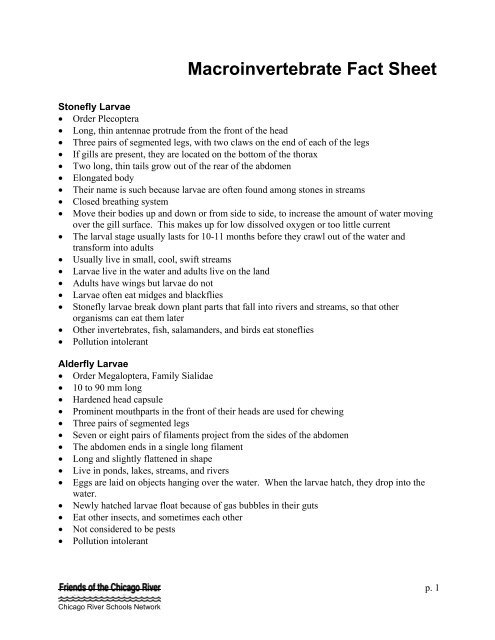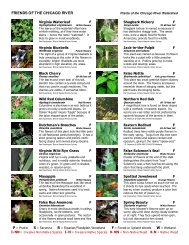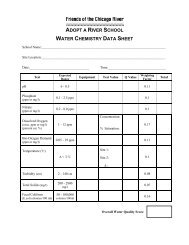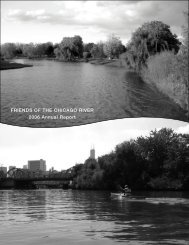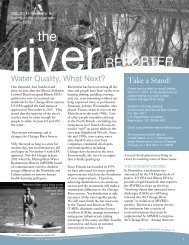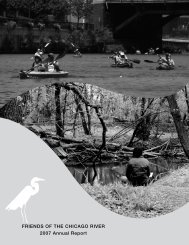Macroinvertebrate Fact Sheet - Friends of the Chicago River
Macroinvertebrate Fact Sheet - Friends of the Chicago River
Macroinvertebrate Fact Sheet - Friends of the Chicago River
You also want an ePaper? Increase the reach of your titles
YUMPU automatically turns print PDFs into web optimized ePapers that Google loves.
<strong>Chicago</strong> <strong>River</strong> Schools Network<br />
<strong>Macroinvertebrate</strong> <strong>Fact</strong> <strong>Sheet</strong><br />
Stonefly Larvae<br />
• Order Plecoptera<br />
• Long, thin antennae protrude from <strong>the</strong> front <strong>of</strong> <strong>the</strong> head<br />
• Three pairs <strong>of</strong> segmented legs, with two claws on <strong>the</strong> end <strong>of</strong> each <strong>of</strong> <strong>the</strong> legs<br />
• If gills are present, <strong>the</strong>y are located on <strong>the</strong> bottom <strong>of</strong> <strong>the</strong> thorax<br />
• Two long, thin tails grow out <strong>of</strong> <strong>the</strong> rear <strong>of</strong> <strong>the</strong> abdomen<br />
• Elongated body<br />
• Their name is such because larvae are <strong>of</strong>ten found among stones in streams<br />
• Closed breathing system<br />
• Move <strong>the</strong>ir bodies up and down or from side to side, to increase <strong>the</strong> amount <strong>of</strong> water moving<br />
over <strong>the</strong> gill surface. This makes up for low dissolved oxygen or too little current<br />
• The larval stage usually lasts for 10-11 months before <strong>the</strong>y crawl out <strong>of</strong> <strong>the</strong> water and<br />
transform into adults<br />
• Usually live in small, cool, swift streams<br />
• Larvae live in <strong>the</strong> water and adults live on <strong>the</strong> land<br />
• Adults have wings but larvae do not<br />
• Larvae <strong>of</strong>ten eat midges and blackflies<br />
• Stonefly larvae break down plant parts that fall into rivers and streams, so that o<strong>the</strong>r<br />
organisms can eat <strong>the</strong>m later<br />
• O<strong>the</strong>r invertebrates, fish, salamanders, and birds eat stoneflies<br />
• Pollution intolerant<br />
Alderfly Larvae<br />
• Order Megaloptera, Family Sialidae<br />
• 10 to 90 mm long<br />
• Hardened head capsule<br />
• Prominent mouthparts in <strong>the</strong> front <strong>of</strong> <strong>the</strong>ir heads are used for chewing<br />
• Three pairs <strong>of</strong> segmented legs<br />
• Seven or eight pairs <strong>of</strong> filaments project from <strong>the</strong> sides <strong>of</strong> <strong>the</strong> abdomen<br />
• The abdomen ends in a single long filament<br />
• Long and slightly flattened in shape<br />
• Live in ponds, lakes, streams, and rivers<br />
• Eggs are laid on objects hanging over <strong>the</strong> water. When <strong>the</strong> larvae hatch, <strong>the</strong>y drop into <strong>the</strong><br />
water.<br />
• Newly hatched larvae float because <strong>of</strong> gas bubbles in <strong>the</strong>ir guts<br />
• Eat o<strong>the</strong>r insects, and sometimes each o<strong>the</strong>r<br />
• Not considered to be pests<br />
• Pollution intolerant<br />
p. 1
Dobsonfly Larvae<br />
• Order Megaloptera, Family Corydalidae<br />
• 10 to 90 mm long<br />
• Hardened head capsule<br />
• Prominent mouthparts in <strong>the</strong> front <strong>of</strong> <strong>the</strong>ir heads are used for chewing<br />
• Three pairs <strong>of</strong> segmented legs<br />
• Seven or eight pairs <strong>of</strong> filaments project from <strong>the</strong> sides <strong>of</strong> <strong>the</strong> abdomen<br />
• Abdomen ends in a pair <strong>of</strong> short, spiny prolegs with two hooks on each<br />
• Body is long and slightly flattened in shape<br />
• Larvae are very large and active<br />
• Brea<strong>the</strong> through gills and <strong>the</strong> s<strong>of</strong>t portions <strong>of</strong> <strong>the</strong>ir skin<br />
• Live in streams and rivers, and areas with running water<br />
• Usually eat larvae <strong>of</strong> mayflies, blackflies, caddisflies, and midges<br />
• Also known as hellgrammites and are used as fishing bait<br />
• Pollution intolerant<br />
Snipe Fly Larvae<br />
• Order Diptera, Family A<strong>the</strong>ricidae<br />
• 12 to 18 mm long<br />
• Undeveloped head with parallel hooks as <strong>the</strong> mouthparts<br />
• Abdomen has 15 prolegs<br />
• The last abdominal segment has two long, fringed appendages<br />
• Body is a long, slightly flattened cylinder shape<br />
• Live under stones in rivers and streams<br />
• Eat larvae <strong>of</strong> midges and mayflies, or o<strong>the</strong>r aquatic invertebrates<br />
• Pollution intolerant<br />
Caddisfly Larvae<br />
• Order Trichoptera<br />
• Cylinder-shaped body<br />
• Hardened head and a s<strong>of</strong>ter abdomen<br />
• Three pairs <strong>of</strong> segmented legs<br />
• Pair <strong>of</strong> prolegs are present with a single claw on each on <strong>the</strong> end <strong>of</strong> <strong>the</strong> abdomen<br />
• Live in rivers, streams, ponds, and lakes<br />
• Construct portable houses for <strong>the</strong>mselves out <strong>of</strong> silk, and drag <strong>the</strong>ir homes around with <strong>the</strong>m<br />
• Many kinds have single or branched gills on <strong>the</strong>ir abdomens<br />
• Brea<strong>the</strong> by dissolved oxygen diffusing across <strong>the</strong> s<strong>of</strong>t tissue parts <strong>of</strong> <strong>the</strong>ir bodies. A current<br />
<strong>of</strong> water running inside <strong>the</strong>ir portable homes when <strong>the</strong>y wiggle <strong>the</strong>ir bodies insures <strong>the</strong>ir<br />
dissolved oxygen supply<br />
• Many catch <strong>the</strong>ir food (small invertebrates, plant parts, algae) in a variety <strong>of</strong> ways, including<br />
with nets constructed <strong>of</strong> silk<br />
• Break down leaves and o<strong>the</strong>r material so <strong>the</strong>y can be eaten by o<strong>the</strong>r organisms<br />
• Moderately pollution intolerant<br />
<strong>Chicago</strong> <strong>River</strong> Schools Network<br />
p. 2
Mayfly Larvae<br />
• Order Ephemeroptera<br />
• Elongated body shape<br />
• Well-developed eyes<br />
• Slender antennae<br />
• Three pairs <strong>of</strong> segmented legs with one claw on <strong>the</strong> end <strong>of</strong> each<br />
• The abdominal segments have fea<strong>the</strong>ry or plate-like gills<br />
• Ei<strong>the</strong>r two or three long, thin tails extend from <strong>the</strong> end <strong>of</strong> <strong>the</strong> abdomen<br />
• Many species emerge from <strong>the</strong> water as adults during <strong>the</strong> month <strong>of</strong> May<br />
• Larvae live in stones and plants found in <strong>the</strong> water<br />
• An important part <strong>of</strong> <strong>the</strong> food web as <strong>the</strong>y eat algae and dead plants<br />
• Eaten by fish<br />
• When <strong>the</strong>re are many mayflies in an area, it is a sign that <strong>the</strong> aquatic environment is healthy<br />
• Moderately pollution intolerant<br />
Riffle Beetle (Larvae and Adult)<br />
• Order Coleoptera, Family Elmidae<br />
• 1 to 10 mm in length<br />
• Tube-shaped<br />
• Dark in color and hard-shelled with a lea<strong>the</strong>ry appearance<br />
• Three sets <strong>of</strong> jointed legs, each with a single claw<br />
• The end <strong>of</strong> <strong>the</strong> abdomen has an operculum which can close over <strong>the</strong> anal gills<br />
• Use <strong>the</strong>ir legs to cling onto objects<br />
• Both <strong>the</strong> larvae and <strong>the</strong> adults typically live in streams and small rivers under stones or in<br />
small crevices<br />
• Primarily eat algae or dead material<br />
• Newly-emerged adults can fly, but lose this ability once <strong>the</strong>y enter <strong>the</strong> water<br />
• Adult riffle beetles can “brea<strong>the</strong>” underwater—once <strong>the</strong>y are underwater <strong>the</strong>y never need to<br />
come up for air again<br />
• Moderately pollution intolerant<br />
Water Penny Beetle Larvae<br />
• Order Coleoptera, Family Psephenidae<br />
• 4 to 40 mm in length<br />
• Oval and very flat in shape<br />
• The mouth parts and three pairs <strong>of</strong> jointed legs are only visible from <strong>the</strong> underside<br />
• Five pairs <strong>of</strong> finely branched gills are visible from <strong>the</strong> underside<br />
• Brea<strong>the</strong> across <strong>the</strong>ir body surface and through gills on <strong>the</strong>ir abdomen<br />
• Live on stones in moving water<br />
• To eat, <strong>the</strong>y scrape algae with <strong>the</strong>ir mouths <strong>of</strong>f rocks<br />
• Grip onto rocks with <strong>the</strong> plates covering <strong>the</strong>ir bodies and with <strong>the</strong> hairs around <strong>the</strong> edge <strong>of</strong><br />
<strong>the</strong>ir bodies<br />
• Their grip is so strong <strong>the</strong>y can be difficult to remove from surfaces<br />
• Moderately pollution intolerant<br />
<strong>Chicago</strong> <strong>River</strong> Schools Network<br />
p. 3
Damselfly Larvae<br />
• Order Odonata, Suborder Zygoptera<br />
• 15 to 30 mm in length<br />
• Slender, tapering body<br />
• Large eyes and antennae<br />
• The lower mouthpart is longer than <strong>the</strong> head<br />
• Three sets <strong>of</strong> segmented legs with two claws on each<br />
• Three gills resembling tails extend from <strong>the</strong> abdomen<br />
• Do not have gills along <strong>the</strong> sides <strong>of</strong> <strong>the</strong> abdomen<br />
• Named for <strong>the</strong>ir delicate appearance and feeble flight<br />
• Live in still water<br />
• Swim by waving <strong>the</strong>ir abdomens from side to side<br />
• Capture <strong>the</strong>ir prey in <strong>the</strong>ir mouths<br />
• Primarily eat zooplankton, flies (particularly mayflies), and mosquitoes<br />
• Eaten by birds<br />
• Not considered to be pests<br />
• Moderately pollution intolerant<br />
Dragonfly Larvae<br />
• Order Odonata, Suborder Anisoptera<br />
• 20 to 50 mm in length<br />
• Long, oval, robust body<br />
• Three sets <strong>of</strong> segmented legs with two claws on each<br />
• Large eyes and antennae<br />
• The lower mouthpart is longer than <strong>the</strong> head<br />
• Two pairs <strong>of</strong> developing wing pads may be visible<br />
• There are no visible external gills<br />
• Three short tail-like spines may be found at <strong>the</strong> end <strong>of</strong> <strong>the</strong> abdomen<br />
• Named for <strong>the</strong>ir fierce appearance and <strong>the</strong>ir bold, aggressive flight<br />
• Live in still water<br />
• Propel <strong>the</strong>mselves forward in <strong>the</strong> water by expelling bursts <strong>of</strong> water behind <strong>the</strong>m<br />
• Capture <strong>the</strong>ir prey in <strong>the</strong>ir mouths—zooplankton, mayflies, and small fish<br />
• Not considered pests because <strong>the</strong>y eat mosquitoes and flies<br />
• Eaten by birds<br />
• Moderately pollution intolerant<br />
Crane Fly Larvae<br />
• Order Diptera, Family Tipulidae<br />
• 10 to 50 mm in length<br />
• Elongated and s<strong>of</strong>t bodied<br />
• Small, hardened head that may be retracted into <strong>the</strong> body<br />
• True legs are absent (may have poorly developed prolegs that look like little bumps on <strong>the</strong><br />
sides <strong>of</strong> <strong>the</strong> abdomen)<br />
• Protrusions at <strong>the</strong> end <strong>of</strong> <strong>the</strong> abdomen<br />
<strong>Chicago</strong> <strong>River</strong> Schools Network<br />
p. 4
• May have gills on <strong>the</strong> end <strong>of</strong> <strong>the</strong> abdomen<br />
• Can make <strong>the</strong> muscles on <strong>the</strong> end <strong>of</strong> <strong>the</strong>ir abdomen into a large knot, which <strong>the</strong>y can wedge<br />
in between rocks when <strong>the</strong>y catch prey in <strong>the</strong>ir mouths<br />
• Live around stones and plant material in streams<br />
• Eat dead material, algae, and o<strong>the</strong>r small organisms<br />
• Break down <strong>the</strong> tree leaves, making <strong>the</strong> energy in <strong>the</strong>m available to o<strong>the</strong>r organisms<br />
• Are used as fish bait<br />
• Moderately pollution intolerant<br />
Crayfish<br />
• Order Decapoda, Families Astacidae and Cambaridae<br />
• Think, hard skin<br />
• Cylindrical body<br />
• Five pairs <strong>of</strong> legs, with pinchers on <strong>the</strong> ends <strong>of</strong> <strong>the</strong> first 2 or 3 sets<br />
• A flipper is found on <strong>the</strong> last segment <strong>of</strong> <strong>the</strong> abdomen<br />
• Two pairs <strong>of</strong> antennae are found on <strong>the</strong> head, with one pair being much longer than <strong>the</strong> o<strong>the</strong>r<br />
• Two large compound eyes are present which may be moved around on <strong>the</strong> end <strong>of</strong> stalks<br />
• Live in all types <strong>of</strong> aquatic environments, including streams and lakes<br />
• Hide in crevices<br />
• They must keep <strong>the</strong>ir gills wet to brea<strong>the</strong>, so <strong>the</strong>y burrow to an underground level deep<br />
enough to be in <strong>the</strong> water<br />
• To defend <strong>the</strong>mselves <strong>the</strong>y pinch with <strong>the</strong>ir claws, or while trying to run away, <strong>the</strong>ir leg will<br />
break <strong>of</strong>f (regeneration does occur)<br />
• Eat live and dead plants, snails, insects, small fish, and fish eggs<br />
• Used for fish bait or food for humans<br />
• Can live as long as 6-8 years<br />
• Moderately pollution intolerant<br />
Clams/Mussels<br />
• Class Bivalva<br />
• Mollusks with two shells that are connected at <strong>the</strong> top<br />
• The muscular foot on <strong>the</strong> bottom front is used for movement<br />
• The body tissue inside <strong>the</strong> shells is pinkish or grayish<br />
• 2 to 250 mm in length<br />
• Brea<strong>the</strong> with gills<br />
• Found in lakes, streams, and rivers<br />
• Bury <strong>the</strong>mselves in gravel or sand<br />
• Are filter feeders that feed on algae, bacteria, and dead material<br />
• Keep <strong>the</strong> amount <strong>of</strong> algae down<br />
• Food for birds, turtles, frogs, fish, and people, as well as o<strong>the</strong>r animals<br />
• Pearls grow inside <strong>the</strong>m<br />
• Many have died because <strong>of</strong> pollution and man-made changes to rivers, such as dams<br />
• Moderately pollution intolerant<br />
<strong>Chicago</strong> <strong>River</strong> Schools Network<br />
p. 5
Blackfly Larvae<br />
• Order Diptera, Family Simuliidae<br />
• Elongated and s<strong>of</strong>t bodied<br />
• True legs are absent but may have a single proleg on <strong>the</strong> thorax<br />
• Club-shaped body that is slightly larger around on one end than on <strong>the</strong> o<strong>the</strong>r<br />
• Fanlike mouth brushes may be visible<br />
• Has tiny hooks on <strong>the</strong> end <strong>of</strong> <strong>the</strong> abdomen that may be used to anchor it to rocks<br />
• 3 to 12 mm in length<br />
• Oxygen is diffused through <strong>the</strong> surface <strong>of</strong> <strong>the</strong> body<br />
• Attach to rocks or plants in rivers or streams and filter food particles from <strong>the</strong> passing water<br />
with <strong>the</strong>ir mouth brushes<br />
• Eat algae, bacteria, and dead material<br />
• Attach <strong>the</strong>mselves to a rock or o<strong>the</strong>r surface by a sticky silk thread, which acts as a lifeline in<br />
case <strong>the</strong>y are swept away by <strong>the</strong> current. They can also use it to move from spot to spot<br />
• Fairly pollution tolerant<br />
Scud<br />
• Order Amphipoda<br />
• 5 to 20 mm in length<br />
• Body is flattened from side to side<br />
• Resembles shrimp<br />
• Seven pairs <strong>of</strong> legs, with <strong>the</strong> first two pairs having claws<br />
• Two pairs <strong>of</strong> antennae<br />
• Six pairs <strong>of</strong> short appendages are on <strong>the</strong> bottom <strong>of</strong> <strong>the</strong> end <strong>of</strong> <strong>the</strong> abdomen<br />
• The name comes from <strong>the</strong> Norwegian word skudda, meaning “to push”<br />
• Also called “sideswimmers” or “amphipods”<br />
• Swim and move along <strong>the</strong> ground on <strong>the</strong>ir sides<br />
• Brea<strong>the</strong> through gills<br />
• Usually live on <strong>the</strong> bottom in shallow water <strong>of</strong> ponds, lakes, and streams<br />
• Mostly eat dead material but also eat fungi, algae, and bacteria<br />
• An important food source for many fish<br />
• If <strong>the</strong>ir habitat lacks fish, <strong>the</strong>re can be as many as 10,000 scuds covering one square meter <strong>of</strong><br />
stream or lake bottom.<br />
• Have negative phototaxis, which means that <strong>the</strong>y avoid bright light, and thus are active at<br />
night<br />
• Fairly pollution tolerant<br />
Right-handed/O<strong>the</strong>r Snails<br />
• Class Gastropoda<br />
• Single cone-shaped and sometimes spiraled shell<br />
• 4 to 44 mm in length<br />
• Right-handed snails have <strong>the</strong> shell opening on <strong>the</strong> right when <strong>the</strong> shell is pointed upward<br />
• Mollusks<br />
• The snail inside has a prominent head with teeth and tentacles<br />
<strong>Chicago</strong> <strong>River</strong> Schools Network<br />
p. 6
• It uses its muscular foot for movement and to seal <strong>the</strong> shell when it retracts into <strong>the</strong> inside<br />
• Live in freshwater ponds, lakes, swamps, and <strong>the</strong> slow parts <strong>of</strong> streams<br />
• Many scrape algae <strong>of</strong>f rocks with <strong>the</strong>ir radula—a hard, many-too<strong>the</strong>d tongue<br />
• Important because <strong>the</strong>y help keep algae growth down<br />
• Fish, amphibians, and waterfowl feed on <strong>the</strong>m<br />
• Travel on a path <strong>of</strong> slime excreted by <strong>the</strong>ir foot<br />
• Fairly pollution tolerant<br />
Midge Larvae<br />
• Order Diptera, Family Chironomidae<br />
• 2 to 20 mm in length<br />
• Elongated and s<strong>of</strong>t bodied<br />
• Often curled<br />
• True legs are absent but paired, hooked prolegs on ei<strong>the</strong>r end may be present<br />
• Hardened head capsule<br />
• Dissolved oxygen diffuses over <strong>the</strong> surface <strong>of</strong> <strong>the</strong> body<br />
• Considered to be “true flies”<br />
• Live in all kinds <strong>of</strong> aquatic environments<br />
• Live inside tubes <strong>the</strong>y construct out <strong>of</strong> dirt particles held toge<strong>the</strong>r by silk<br />
• Eat bits <strong>of</strong> food that <strong>the</strong>y collect from <strong>the</strong> bottom or filter from <strong>the</strong> water with a net<br />
constructed <strong>of</strong> silk<br />
• Eaten by fish and waterfowl<br />
• Fairly pollution tolerant<br />
Sowbug<br />
• Order Isopoda, Family Asellidae<br />
• Crustacean related to <strong>the</strong> pillbug<br />
• Seven pairs <strong>of</strong> legs, with claws on <strong>the</strong> first pair<br />
• Brownish and <strong>of</strong>ten mottled in color<br />
• Hard bodied<br />
• Flattened from top to bottom<br />
• 5 to 20 mm in length<br />
• Live in crevices in shallow water<br />
• Usually feed on particles <strong>of</strong> dead plants and animals<br />
• Eaten by some invertebrates like crayfish and bottom-feeding fish<br />
• Fairly pollution tolerant<br />
Aquatic Worms<br />
• Class Oligochaeta<br />
• 1 to 30 mm in length<br />
• S<strong>of</strong>t bodied, elongate, and cylinder-shaped<br />
• The body consists <strong>of</strong> many ring-like segments (usually 40-200)<br />
• Each segment has tiny bundles <strong>of</strong> hairs called chaetae<br />
• Does not have suckers or eyespots<br />
<strong>Chicago</strong> <strong>River</strong> Schools Network<br />
p. 7
• Move by contracting <strong>the</strong>ir muscular body wall and by pushing on <strong>the</strong> surrounding dirt with<br />
little bundles <strong>of</strong> hairs<br />
• Many live in <strong>the</strong> soil at <strong>the</strong> bottoms <strong>of</strong> lakes, ponds, and slow-moving rivers<br />
• Mix <strong>the</strong> first 5 to 10 cm <strong>of</strong> sediment on lake bottoms, so organisms that live in <strong>the</strong> sediment<br />
get enough dissolved oxygen<br />
• Many eat mud, sifting out food particles to be eaten. O<strong>the</strong>rs eat bacteria, protozoa, algae, and<br />
even small invertebrates<br />
• Eaten by invertebrates and fish<br />
• Very pollution tolerant<br />
Leech<br />
• Class Hirudinea<br />
• Usually are 5 to 100 mm in length<br />
• S<strong>of</strong>t but muscular body<br />
• Elongated, flattened from top to bottom<br />
• There are actual 34 segments, which may be subdivided<br />
• The first few segments have several eyespots on <strong>the</strong>m<br />
• There are two suckers on <strong>the</strong> body—one on <strong>the</strong> front and one on <strong>the</strong> rear<br />
• Look like flattened worms<br />
• Usually found in shallow areas <strong>of</strong> ponds, lakes, and slow-moving rivers<br />
• In suitable areas <strong>the</strong>re may be as many as 700 per square meter <strong>of</strong> bottom<br />
• Dissolved oxygen is absorbed over <strong>the</strong> body’s surface<br />
• Sometimes <strong>the</strong>y can survive for several days without oxygen<br />
• Some swallow <strong>the</strong>ir prey whole—insect larvae, aquatic earthworms, snails, and o<strong>the</strong>r<br />
leeches. O<strong>the</strong>rs attach <strong>the</strong>mselves to a host and suck its blood<br />
• In <strong>the</strong> past <strong>the</strong>y were used by doctors to heal sick people<br />
• Fish, snakes, birds, and insects eat <strong>the</strong>m<br />
• They decrease <strong>the</strong> number <strong>of</strong> fish in hatcheries<br />
• Very pollution tolerant<br />
Pouch/Left-Handed Snails<br />
• Class Gastropoda<br />
• Single cone-shaped and sometimes spiraled shell<br />
• 4 to 44 mm in length<br />
• Left-handed snails have <strong>the</strong> shell opening on <strong>the</strong> left when <strong>the</strong> shell is pointed upward.<br />
• The snail inside has a prominent head with teeth and tentacles<br />
• It uses its muscular foot for movement and to seal <strong>the</strong> shell when it retracts into <strong>the</strong> inside<br />
• Live in freshwater ponds, lakes, swamps, and <strong>the</strong> slow parts <strong>of</strong> streams<br />
• Many scrape algae <strong>of</strong>f rocks with <strong>the</strong>ir radula—a hard, many-too<strong>the</strong>d tongue<br />
• They are important because <strong>the</strong>y help keep algae growth down<br />
• Fish, amphibians, and waterfowl feed on <strong>the</strong>m<br />
• Travel on a path <strong>of</strong> slime excreted by <strong>the</strong>ir foot<br />
• Very pollution tolerant<br />
<strong>Chicago</strong> <strong>River</strong> Schools Network<br />
p. 8
Bloodworm Midge Larvae<br />
• Order Diptera, Family Chironomidae<br />
• 2 to 20 mm in length<br />
• Elongated and s<strong>of</strong>t bodied<br />
• Often curled<br />
• True legs are absent but paired, hooked prolegs on ei<strong>the</strong>r end may be present<br />
• Hardened head capsule<br />
• Dissolved oxygen diffuses over <strong>the</strong> surface <strong>of</strong> <strong>the</strong> body<br />
• Bright red in color because <strong>of</strong> <strong>the</strong> oxygen stored in <strong>the</strong> hemoglobin <strong>of</strong> <strong>the</strong>ir blood<br />
• Because <strong>the</strong>y can store oxygen, <strong>the</strong>y can exist in highly polluted or organically rich aquatic<br />
areas<br />
• Live in deep waters, like <strong>the</strong> bottoms <strong>of</strong> lakes<br />
• Live inside tubes <strong>the</strong>y construct out <strong>of</strong> dirt particles held toge<strong>the</strong>r by silk<br />
• Eat bits <strong>of</strong> food that <strong>the</strong>y collect from <strong>the</strong> bottom or filter from <strong>the</strong> water with a net<br />
constructed <strong>of</strong> silk<br />
• Eaten by fish and waterfowl<br />
• Very pollution tolerant<br />
<strong>Chicago</strong> <strong>River</strong> Schools Network<br />
p. 9


